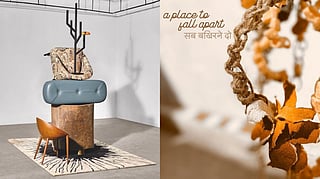- #HGWORLD
- #HGCREATORS
- #HGEXPLORE
- #HGVOICES
- #HGSHOP
- CAREERS
- ABOUT US
- CONTACT US

One of my favourite TikTok trends right now is called ‘every girl has a box’. It's as simple as it sounds: every girl has a box of doodads from a few years ago in her life that she may or may not have forgotten about. When you open it, the contents of this box look random on the surface but if you know how to look, and I mean really look, there's an underlying narrative connecting these objects: a window into what her life was about in the time that she collected these things.
Humans have an innate inclination to imbue objects with meaning. From ancient talismans that we crafted for protection, luck, or a deeper connection to the universe to the modern-day charm bracelet that friends give each other, this impulse to find significance in the material world is deeply ingrained in our psyche.
Sculpture, in its essence, is the art of giving form to these intangible desires and beliefs. It is a tangible manifestation of the human spirit, a three-dimensional narrative frozen in time. Like a collage of objects assembled to create a new image, sculptures are composed of shapes and textures that coalesce into a potent visual story. They can either give concrete form to existing concepts or, through their innovative expression, birth entirely new ones.
Representing the lifestyles, systems and anxieties of a digital world through a contemporary lens, a new wave of homegrown artists are using objects as their canvas.
Deepikah Bhardwaj, a Toronto-based Indian artist, employs sculpture as a powerful tool to construct intricate narratives that intersect ecology, gender, and perception. Hailing from a deeply patriarchal Indian upbringing, her artistic journey is a rebellion against societal norms and a quest for self-discovery.
Her works, such as ‘Nature Not Mother’, gives form to forces of nature that are unseen in the human rat race of development. Through immersive installations it counters the existing idea that the human species are at the center of the world and underlines the notion that earth's resources aren't at our disposal to disregard and misuse. It equalises us with nature and showcases how we are mortal and a part of the larger cycle of life. On the other hand, projects like ‘Bad Mama’ delve into the complexities of motherhood and its thankless nature; exposing the often-silenced narratives of women. It sheds light on the misogyny and double standards surrounding motherhood, for example: take-out for dinner if done by the father is perceived as a fun night but with a mother, it is looked down upon as lazy. Her MFA thesis show uses unconventional materials like algae, kombucha, takeaway containers, gelatine, metal, and plants to highlight how natural and manmade things exist, decay and leave remnants together within ecological systems.
Follow Deepikah here.
Shailesh, a sculptor with roots in a rural Indian upbringing, employs machinery as a medium to deconstruct the intricacies of human existence. His creative process begins with a meticulous sketching phase, where everyday thoughts are transformed into blueprints for potential sculptures. Fascinated by mechanics despite a childhood devoid of electricity, Shailesh simplifies complex machinery to mirror the often unnecessary constructs of human society which may involve social dynamics traditions and etiquettes in the Indian culture. Rooted in Sanskrit and the Tarka Shastra philosophy, his work extends beyond aesthetics, delving into the symbolic and critical analysis of objects. He repurposes everyday items, infusing them with satire to expose their underlying political, social, or cultural implications. Shailesh's ‘Page Turner’ project exemplifies this approach, as it depicts reading as a hollow, mechanical act, ritualistic and blind in nature, of which the underlying mechanism is the perpetuation of systems like casteism, misogyny and other barbaric worldviews.
Follow Shailesh here.
Priyanka Shah is a contemporary artist and designer whose work defies categorization. Her signature style involves transforming ordinary objects into extraordinary sculptures, challenging the boundaries between art and design. Shah’s assemblages are not mere collections of items but intricate narratives woven with everyday elements like antiques, furniture, and even food. Her Still Life’ series, for instance, is a testament to her ability to transform the mundane into the mesmerizing, where inverted chairs, withered vegetables, and delicate ceramics coexist in a surreal harmony. By manipulating form, function, and aesthetics with equal finesse, Shah creates visual symphonies that invite contemplation and question our perceptions of the familiar. Her work speaks to the boundless potential of human creativity, demonstrating that art can emerge from the most unexpected sources.
Follow Priyanka here.
If you enjoyed reading this, here's more from Homegrown:
Material Immaterial Studio's Objects Are A Dialogue Between Architecture & Sculptural Art
The Familiar And The Fantastical: The Legacy Of Sculpture Maestro Prithpal Singh Ladi
How Talia Ramkilawan Uses Soft Sculptures To Disrupt & Heal Post-Apartheid Trauma
